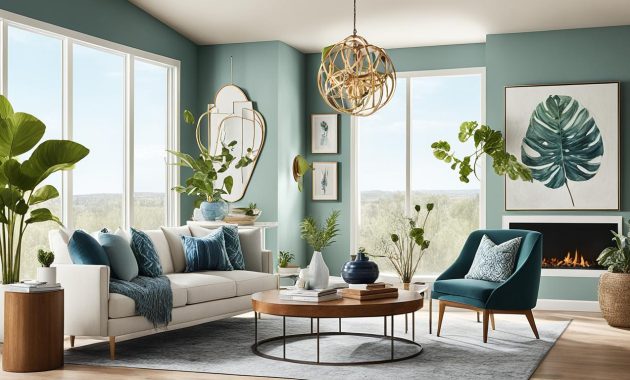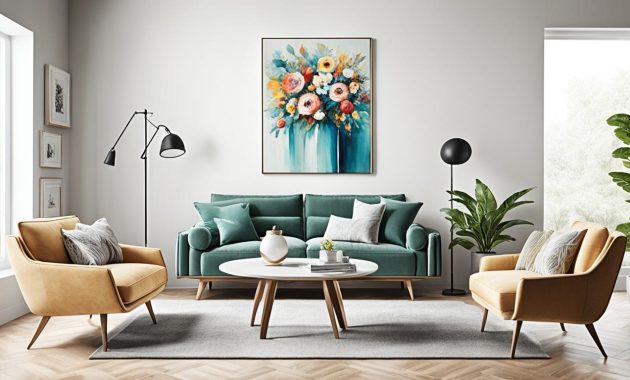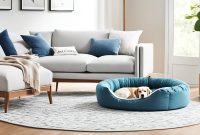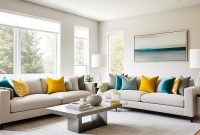Are you ready to make your living or workspace look amazing? Interior design is more than just making things look good. It’s a way to make your space work better, boost your productivity, and show off your style. We’ll share expert tips to help you make your space inspiring.
Whether you live in a house or run a business, these tips will help you use your space well. You’ll learn about planning your space, choosing colors, arranging furniture, and using lighting smartly. Our experts have proven strategies to turn your ideas into reality.

Are you ready to see how expert interior design can change your space? Let’s start exploring the power of great design together.
Key Takeaways
- Discover practical strategies for optimizing your space and enhancing functionality.
- Learn how to curate color palettes that evoke the desired mood and atmosphere.
- Uncover the secret to arranging furniture for both style and comfort.
- Explore innovative lighting solutions to illuminate your space and set the tone.
- Understand the importance of material selection and sustainable design choices.
- Gain insights into creating personalized living areas and embracing branding in commercial spaces.
- Elevate your space and reflect your unique style with expert interior design tips.
The Essence of Interior Design
Interior design blends art and science to make spaces that are both useful and beautiful. It focuses on meeting the needs and likes of those who use the space. Whether it’s a home or a business, the key elements of Interior Design, Home Decor, Residential Design, and Commercial Design are crucial for creating welcoming spaces.
Defining Interior Design
Interior design means planning and putting together the elements of a space for a certain look and feel. It’s about picking and placing furniture, lights, colors, textures, and more to make a space look good and work well.
The Role of an Interior Designer
An interior designer knows the ins and outs of Interior Design, Home Decor, Residential Design, and Commercial Design. They take what the client wants, look at the space, and turn it into a design that’s both useful and beautiful. They work with architects, contractors, and artisans to make their designs come to life.
Key Responsibilities of an Interior Designer Benefits of Hiring an Interior Designer Space planning and layout Furniture and product selection Color and material coordination Lighting design Project management and oversight Optimized use of space Cohesive and visually appealing design Seamless integration of functionality and aesthetics Cost-effective solutions and project management Personalized and tailored design experience
Knowing what interior design is and what designers do helps people make the most of their spaces. It lets them create places that are both useful and beautiful.
Space Planning: The Foundation
Effective space planning is key to great interior design. Designers use smart strategies to make the most of a space’s layout and flow. They make sure it works well and looks good. By looking at how people move and use the space, they design areas that meet the needs of residential and commercial clients.
At the core of space planning is understanding functionality. Designers carefully think about how a space will be used. They plan where furniture goes, where work happens, and where important things are placed. This makes the space work well and look good.
Looks matter too. Good designers mix visual appeal with practicality. They divide a space into areas that work together well. This makes the space feel better and improves how people use it.
Key Principles of Effective Space Planning Residential Design Commercial Design Optimizing layout and flow Analyzing spatial requirements Addressing traffic patterns Incorporating ergonomic considerations Balancing functionality and aesthetics Creating personalized living areas Maximizing storage and organization Enhancing comfort and relaxation Fostering productivity and collaboration Aligning with brand identity and image Optimizing workflow and efficiency
Designing for residential or commercial spaces uses the same key ideas. By focusing on functionality and making it look good, designers improve the experience. They make spaces that really connect with their users.
“Successful space planning is about more than just aesthetics – it’s about creating environments that empower people to thrive.” – Jane Doe, Interior Design Expert
Color Schemes: Setting the Mood
In interior design, color is key to creating the right mood and feeling. Knowing about color psychology and the latest color trends can make your design stand out. This is true for both residential and commercial projects.
Color Psychology
Colors deeply affect our mood, thoughts, and actions. Designers use this to create palettes that set the mood in a room. For example, warm tones like red and orange bring energy and vibrancy. On the other hand, cool shades of blue and green make us feel calm and relaxed.
Color Trends and Combinations
The color trends change all the time. Staying updated with these trends keeps you ahead. From calming monochromatic schemes to bold contrasts, the right color combination adds interest and unity to a space. Using trendy yet classic color schemes ensures your design stays stylish and timeless.
Furniture Arrangement: Functional Beauty
Choosing the right furniture and where to put it can make a big difference in how a space looks and works. Finding the perfect balance between looks and use is key. This approach helps make spaces that are both beautiful and practical.
Balancing Form and Function
When arranging furniture, the aim is to blend functionality and design smoothly. Think about how people will move around, see things, and sit comfortably. The furniture should look good together and fit well in the space.
In homes, how furniture is arranged sets the mood of the room. It makes people feel welcome and at ease. In offices, the right furniture setup can help people work better together and make a good impression on visitors.
- Look at the room’s size and shape to figure out the best spot for furniture.
- Put similar items together to make areas like a cozy spot or a desk area.
- Try out different setups to find the perfect mix of looks and use.
- Use furniture that can do more than one thing to make the most of the space.
- Make sure furniture is the right size to look good in the room.

By carefully picking and placing furniture, you can make spaces that look great and work well. This balance is what makes good interior design work, whether it’s for a home or a business.
Lighting Design: Illuminating Your Space
Lighting is key in interior design. It lights up a space and sets the mood. Using natural and artificial light can change a room, making it look amazing. It meets both the Functionality and looks of the space.
For a cozy Residential Design or a lively Commercial Design, Lighting Design is crucial. It shapes the atmosphere. The right lighting can show off architectural details, add depth, and make a room look bigger.
Harnessing the Power of Natural Light
Using natural light is a smart and cost-saving way to improve a space. Windows, skylights, and reflective surfaces can bring in more daylight. This reduces the need for artificial light and makes the space feel bright and open.
Layering Artificial Lighting
When there’s not enough natural light, artificial lighting can help. Mixing different light types, like task, accent, and ambient lighting, adds depth. It highlights important parts and sets the mood you want.
Lighting Type Purpose Examples Task Lighting Illuminates specific areas for focused activities Desk lamps, under-cabinet lighting, reading nooks Accent Lighting Highlights architectural elements or decorative features Wall sconces, track lighting, recessed lighting Ambient Lighting Provides overall, general illumination Chandeliers, pendant lights, floor lamps
Designers use natural and artificial light together to make spaces look great. They make sure the lighting fits the space and its users.
“Lighting has the power to transform a space, evoking emotions and shaping the overall ambiance.”
Material Selection: Texture and Durability
In interior design, the choice of materials greatly affects the look, feel, and durability of a space. Designers must weigh the benefits of natural versus synthetic materials. They should think about the unique qualities and how sustainable each option is.
Natural vs. Synthetic Materials
Natural materials like wood, stone, and fibers bring a warm, organic vibe. They can make a space feel timeless and are often very durable. This makes them a top pick for many designs.
On the flip side, synthetic materials such as plastics and metals offer a modern look. They can be cheaper and easier to keep up. This makes them great for certain projects.
Sustainable Material Choices
There’s a growing need for eco-friendly design, making sustainable materials key. Designers now focus on materials that can be renewed, recycled, or come from responsible sources. This approach lowers environmental harm and helps the space last longer.
Material Texture Durability Sustainability Bamboo Smooth, warm Highly durable Renewable, biodegradable Reclaimed Wood Rustic, unique Durable, long-lasting Recycled, environmentally friendly Cork Soft, textured Durable, moisture-resistant Renewable, biodegradable
Designers should think about the texture, durability, and sustainability of materials. This way, they can make spaces that look great, are good for the planet, and hold their value over time.
Interior Design for Residential Spaces
Making living areas personal is key in Residential Design. Interior designers know each home is special, showing off the unique lives and tastes of its owners. They use Personalization to mix Functionality and Comfort. This makes homes welcoming and in tune with their owners.
Creating Personalized Living Areas
Designing great homes means making them fit the owners’ needs and likes. Interior designers get to know what their clients love and how they live. They pick furniture, colors, and decor that show off the home’s unique vibe and make it feel like home.
It’s important for homes to be practical, too. Designers balance looks with usefulness. They choose furniture that’s useful and layouts that make moving around easy. This helps the home fit the owners’ everyday life.
Comfort is crucial in design, as people want their homes to be relaxing spots. Designers look for comfortable furniture and soft colors. They add inviting textures to make the space cozy and welcoming.
“The ultimate goal of interior design is to create spaces that not only look beautiful but also enhance the overall well-being and enjoyment of the people who inhabit them.”
| Key Elements of Residential Design | Description |
|---|---|
| Personalization | Tailoring the living spaces to reflect the unique preferences, lifestyles, and personalities of the homeowners. |
| Functionality | Designing layouts and incorporating features that support the practical needs and daily activities of the homeowners. |
| Comfort | Creating a cozy, inviting, and relaxing atmosphere through the selection of furnishings, textures, and color schemes. |
Commercial Interior Design
Commercial interior design is about making work spaces that look professional and help employees do their best. It’s about creating areas that show off a company’s brand and make workers happy. This field combines good looks, practicality, and the company’s goals to make a better experience for everyone.
Embracing Branding and Functionality
Good commercial interior designers team up with clients to get what the company stands for and what it needs. They use design elements that match the brand’s look and feel. This makes the space reflect the company’s unique vibe and goals.
At the same time, they make sure the space works well for the business and its people. This means the layout, furniture, and other features support productivity and efficiency.
From sleek corporate offices to lively co-working spots, commercial interior design is key in making work environments great. By mixing Commercial Design, Branding, Functionality, and Productivity, designers turn regular work areas into places that inspire, engage, and drive success.
FAQ
What is the definition of interior design?
Interior design makes buildings more beautiful, functional, and healthy. It uses art and science to improve the inside of buildings.
What are the key responsibilities of an interior designer?
Interior designers plan spaces, pick colors and materials, arrange furniture, and design lighting. They make sure the design meets the client’s wishes and follows the rules.
How important is effective space planning in interior design?
Space planning is key to good interior design. It makes sure a space is useful and looks good. It meets the needs of the people using it.
How does color influence the mood and ambiance of a space?
Color shapes the feel of a space. Designers use color psychology and trends to pick colors that set the mood and match the design.
What is the importance of balancing form and function in furniture arrangement?
Placing and choosing furniture right is crucial. It makes a space look good and work well. Designers aim for a mix of beauty and practicality.
How can lighting design contribute to the ambiance and functionality of a space?
Lighting is vital in design. It lights up a space and sets the mood. Designers use different lights to make areas inviting and beautiful.
What are the considerations for material selection in interior design?
Choosing materials matters a lot in design. Designers look at natural and synthetic options and think about sustainability. They pick materials that look good, feel good, and last long.
How do interior designers approach designing for residential spaces?
For homes, designers know how people live and what they need. They make spaces that fit the homeowner’s life and style, making it comfortable and welcoming.
What are the key considerations for commercial interior design?
Commercial design aims to create spaces that are professional and boost productivity. Designers focus on looks, function, and the company’s image to make spaces that improve the user’s experience.



